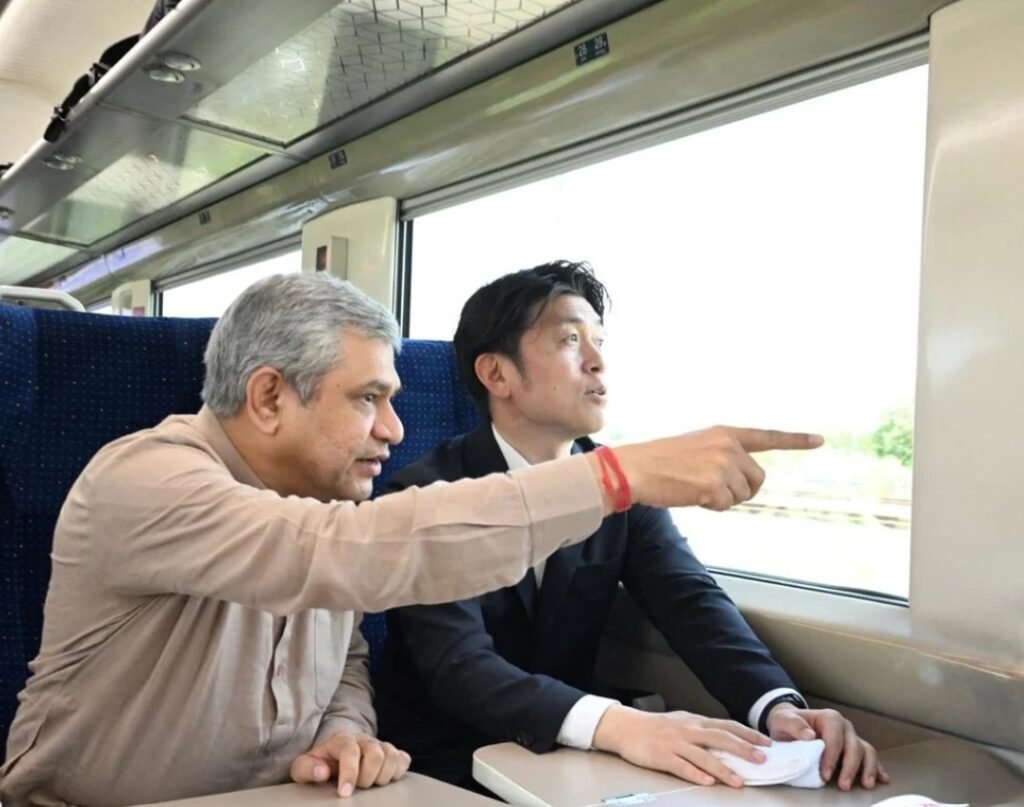STN: Union Railway Minister Ashwini Vaishnaw and Japan’s Minister of Land, Infrastructure, Transport and Tourism Hiromasa Nakano jointly reviewed the progress of the Mumbai–Ahmedabad High-Speed Rail project during an inspection visit to the Surat stretch.
The visit focused on evaluating key construction milestones and ensuring that the work is moving as per schedule. Both leaders examined the facilities and interacted with engineers working on-site.
Review Visit | Bullet Train Work in Surat
The National High Speed Rail Corporation Limited (NHSRCL) confirmed that Minister Nakano and Minister Vaishnaw visited the construction site in Surat. They reviewed major components such as the track slab laying car and the track slab adjustment facility.
Officials explained how these systems are essential for the smooth installation of high-speed tracks. The ministers also checked the safety and quality control measures being followed at the site.
NHSRCL stated that both ministers were satisfied with the progress and praised the teams for maintaining high standards of work. The visit highlighted the importance of the Surat Bullet Train Project as a key part of India’s first high-speed rail corridor.
Ongoing Work and International Cooperation
Hiromasa Nakano’s visit took place just a month after Prime Minister Narendra Modi travelled on Japan’s Shinkansen bullet train with Prime Minister Shigeru Ishiba. The visit underlined the ongoing collaboration between India and Japan on the high-speed rail initiative.
The project is being built with Japanese technology and financial support. It aims to bring the same reliability and speed that Japan’s Shinkansen network is known for.
Project Overview: Mumbai–Ahmedabad High-Speed Rail
The Mumbai–Ahmedabad High-Speed Rail corridor will be India’s first bullet train line. It covers a distance of 508.17 km and will connect Mumbai in Maharashtra with Ahmedabad in Gujarat.
The route will have 12 stations, including Mumbai (Bandra Kurla Complex), Thane, Virar, Boisar, Vapi, Bilimora, Surat, Bharuch, Vadodara, Anand/Nadiad, Ahmedabad, and Sabarmati.
Once operational, the train is expected to reduce travel time between Mumbai and Ahmedabad from nearly six hours to around two hours.
Importance of Surat in the Project
Surat plays a vital role in the overall project due to its central location and strong industrial base. The Surat Bullet Train Project section involves some of the most advanced construction work, including large-scale viaducts and modern station facilities.
The city’s progress is being closely monitored as it sets the pace for other sections of the corridor. The work in Surat is expected to serve as a model for other high-speed rail developments in India.
FAQs on Surat Bullet Train Project
A: The Surat section is one of the most advanced parts of the project. Construction of bridges, viaducts, and station works is in progress.
A: According to recent updates from NHSRCL, the first phase between Surat and Bilimora is expected to start before the entire corridor becomes operational.

